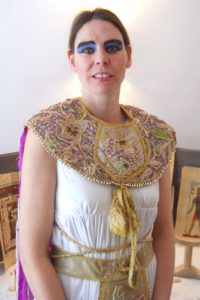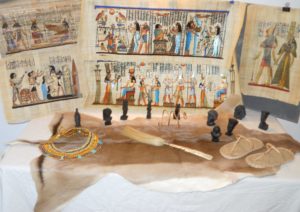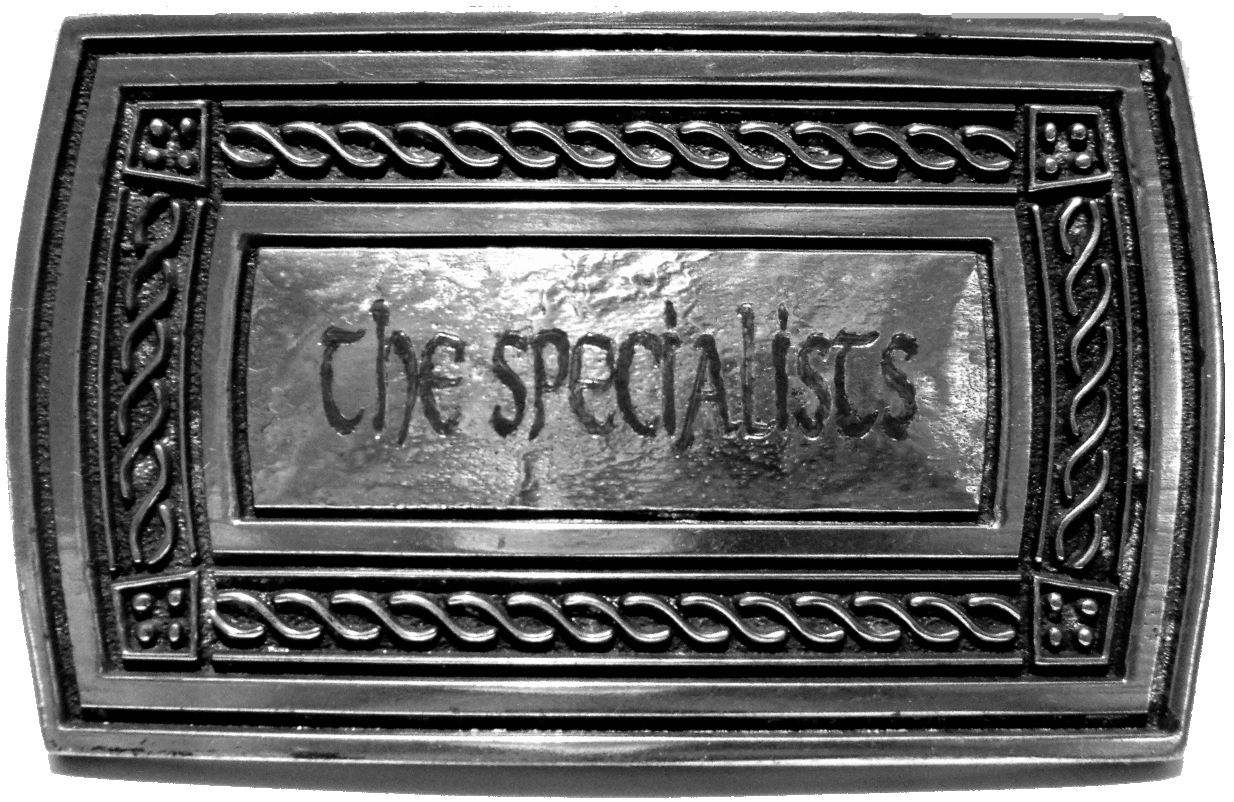101 Egyptian Facts

- Imhotep could be considered the first ever known architect as he planned the first Step Pyramids.
- The Great Sphinx of Giza is 4,500 years old.
- The earliest evidence of juggling is from over 4,000 years ago in the ancient Egyptian times. Images in a tomb show women juggling together.
- Dentists thought that there were tooth worms that were causing tooth decay and tooth problems. They would pray to the Gods to take away the worms and give the patients medicine to help with the pain. I’m not sure if this worked as Queen Hatshepsut died with a tooth abscess … she should have changed her dentist!
- Pyramids can take about twenty-three years to build … for just one pyramid!
- The River Nile is one of the longest rivers in the world. It’s about 6,670 KM (4,160 miles) long.
- The ancient Egyptians believed in the afterlife. They thought the afterlife was very similar to life on earth but with no grief or sorrow. They believed that a second self, called the ka lived within every human being. When the physical body expired, the ka enjoyed eternal life.
- Howard Carter and his team were able to work out that King Tut likely died in March or April due to the flowers that were buried close to his body.
- Glass was scarce and very expensive. Tomb raiders would melt it down to make new objects and the theft couldn’t be traced back to them … clever!
- Artists wanted to paint realistically so would paint faces in profile. They didn’t use shading so it was easier for the nose to look correct. It’s also easier to identify a person if their face, arms and legs are in profile. An eye and shoulder would face the front though. This may be why people think ancient Egyptians walk in a certain way…. Walk like an Egyptian!
- Ancient Egyptians would pray to and give offerings to the Nile God Hapi in the hope that the Nile would flood each year. They didn’t understand that the flood was really caused by heavy rain in the Ethiopian Mountains, which caused the river to flood over the flat desert land in Egypt.
- Soldiers fought with axes, spears and javelins made with wooden handles and bronze blades – ouch!
- Mummies are wrapped in linen but royalty also had golden bands wrapped over the linen.
- All Egyptians wore linen clothing. Linen is probably the first ever textile. The method of how the flax plant was used to make linen is shown in tomb paintings.
- The doctors carrying out surgery would use equipment and instruments that are still being used today in medicine. These include: scalpels, dental pliers, a bone saw, probes, clamps (for stopping blood flow), sponges, scissors and linen bandages.
- Everyone enjoyed music. Instruments included tambourines, flutes, lyres, castanets and tall harps. We don’t know what the music sounded like but we know from tomb paintings that Egyptians enjoyed dancing and being entertained so it was likely to be fast paced and happy music.
- There is no evidence of Egyptian theatre but we know that plays about the gods were performed at festivals.
- Once a mummy was laid to rest in their coffin, the priests would back out of the chamber sweeping away their footprints. The door was then sealed so that no one could enter and disturb the mummy or their possessions.
- The Great Pyramid of Giza was the tallest man-made structure for over 3800 years and is one of the Seven Wonders of the World.
- Ancient Egyptians would enjoy the following pastimes: rowing boats on the River Nile, horse riding, running games, boxing and wrestling, playing tug-o-war and playing hockey (with balls made from leather and papyrus).
- Illness was thought to be because the patient had upset a god. So praying to the gods and presenting offering/presents were seen as practical ways to help sufferers.
- Some early Egyptians have been found buried in pits in the desert. The hot dry sand preserved some of the bodies for five thousand years!
- The pyramids were built about 4000 years ago.
- The wind usually blows from North to South along the Nile. If you were sailing south then you could use linen sails. Unfortunately you’d have to get your oars out to row when sailing back home!
- Inside the pyramids, the temperature is a constant twenty degrees Celsius … now that’s early air conditioning!
- You could have your pet mummified with you so you were not lonely in the afterlife … even if they were not actually ready for the afterlife yet!!
- Ask your family to bury shabtis (small clay dolls) with you when you’re mummified to help you with work in the afterlife. The good servants may have already been taken!
- Jewellery was so popular that even pet cats could be seen with rings in their ears or noses! I don’t fancy trying to pierce a cat’s nose!
- Ancient Egyptians were the first people to give us our year with 365 days. Their year was divided up like this: ten days = one week, three weeks = one month, four months = one season, three seasons plus five holy days = one year.
- The Great Pyramid of Giza is the largest pyramid. When it was first built it was over 146m tall. That’s as high as a forty-floor tower block!
- If the Egyptian army killed you then your hand or tongue may be cut off. This helped the scribes count how many had been killed in battle! Eurgh!
- Mirrors for rich people were made from polished bronze. Poor women used the reflection of water instead.
- The dwarf god, Bes looked over homes and families. He’s often shown as a happy god who likes singing and dancing.
- Not one of the pyramids could keep out the tomb raiders. All of them were broken into over time and treasures were lost.
- If you were in the army but didn’t like the idea of fighting then hope you were a charioteer. You would be controlling the two horses pulling the chariot whilst a soldier used a bow and arrow from the back of the chariot.
- It’s thought that the Great Pyramid of Giza was made from 2.3 million blocks of rock…. I bet you’re pleased you weren’t a pyramid builder!
- Bat’s blood was given to anyone with an eye problem. They thought the bat’s ‘night vision’ would then be passed onto the patient. It’s no surprise that there isn’t evidence of this working!!
- In the mummification process its sensible to label bodies so they don’t get mixed up!
- Don’t think about being a tomb raider for a living. If you’re caught you’re likely to be tortured and then have a slow death by impalement!
- When the ancient Egyptian pyramids were first built they were covered in limestone, which sparkled like diamonds when the sun would shine on them. They could be seen from miles away.
- Senat and Mancala are not only two Ancient Egyptian games but also two of the world’s oldest games.
- Embalmers were highly respected due to being responsible for preparing people for the afterlife.
- The world’s first recorded battle was between ancient Egyptians and the Hittites. But there was no real winner as both sides claimed victory.
- The faces on coffins were painted to show the person as being young and beautiful.
- Every Pharaoh has five names. We call Pharaohs by their birth name but Egyptians would call them by their throne name. The Egyptians would have known Tutankhamen as Nebkheprure.
- The word Obelisk comes from the Greek word for needle.
- The pyramids were built to house the bodies of royalty and their families.
- The Rosetta Stone became the key to deciphering hieroglyphics. The stone is inscribed in three different languages, which helped the French scholar Jean-Francois in 1822 understand the language made up with pictures. (The stone was discovered near Rosetta in the Nile Delta in 1799.)
- Most houses were about 5 x 15 meters with a flat roof used as an extra ‘room’.
- Obelisks were symbols of the sun god, Ra. They were usually put up in pairs outside temples and tombs. Some people say they represent rays of sunlight.
- The Sphinx is 73 meters long and 20 meters high and is one of world’s largest monuments.
- Eyes can be taken out of a mummy and replaced by stones or even onions … it’s enough to make you cry!
- Children would often run around naked but still wore jewellery and amulets!
- Make sure there is a scarab beetle amulet in your linen wrappings as a mummy! It will help your guilty secrets stay hidden during the weighing of the heart ceremony. If your heart is found to be heavier than the feather of truth than you will not be allowed in the afterlife.
- Paint colours used to paint in the tombs were made from natural minerals. Black = charcoal, Red = Ochre, White = Powdered Limestone, Blue = copper/ cobalt, Green = malachite, Yellow = iron oxide.
- The Egyptian army was divided into four divisions with 5000 men in each.
- A second hand coffin for a King! The middle coffin for King Tut looked different to the others and is thought not to have originally been made for the King himself.
- When the soldiers were on the move they would make a camp with a moat around it and then placed shields around it to make a protective wall.
- Priests sometimes wore leopard skins over their tunics. The head, paws and tail were often left on. If they weren’t wearing the real thing then sometimes they would have fabric painted or woven to look like leopard skin.
- Girls were often married by the age of 14. Families could arrange the marriage with girls having little choice. Lets hope your parents had good taste!
- Egyptian explorers and traders were keen to get to Nubia which means ‘Gold’. Travel was dangerous but this is how they brought expensive items such as gold, ebony, ivory and even live panthers back to the pharaohs.
- Pyramid workers were buried in tombs close to the pyramid they were building with food and drink for the afterlife.
- Lipstick and blusher made from red ochre were used by women.
- Children would drink beer as it was healthier than drinking the dirty Nile water. Don’t get too excited though as it was very lumpy and sometimes hard to drink.
- The River Nile was the quickest and easiest way to travel around Egypt. There were different types of boats for different purposes. There were cargo boats for trading, funeral barges and fancy royal boats for the pharaoh. There were even ‘cattle boats’ so the farmers could transport their most valuable possession. The cattle showed the wealth of the famer and would be protected at all costs.
- Many Egyptians saved linen throughout their lives to use as wrappings when they were mummified.
- Even though the doctors were well respected you will be pleased that they won’t be treating you! Some of their supplies included animal poo, mouldy bread, dead mice and lizard blood as medicines and dressings!
- Women at banquets would wear cones on top of their wigs filled with perfumed oil. The oily perfume would melt as the evening wore on and ran down their dresses. Try that instead of deodorant and see how you get on!
- The Egyptian word for army means “task force”. Even when they were not fighting and protecting their country they were put to good use as miners or quarrymen.
- If you think that having a pet cat or dog is boring then don’t worry! You could have a monkey or gazelle!
- Everyone believed that the gods controlled everything and would frequently pray to them. Most people had a small chapel in their garden or altar in their house to make this as easy as possible.
- The pyramids are so old that they were a popular tourist site for the ancient Egyptians even back in King Tut’s time…. They were built 2000 years before he was on the throne!
- The multi-talented Imhotep (an accomplished architect) was the first to suggest that disease was a natural occurrence and not a punishment from the gods.
- Frankincense and Myrrh were not just big names at Christmas but were considered valuable gifts all year round and were used in mummification.
- The mineral malachite was ground up and used as a green eye shadow.
- If you didn’t live near an embalmers workshop then your body would be placed on a funeral boat to sail along the Nile. You would sail with dignity and respect.
- Women had a skin regime and would use cleansing creams and body scrubs.
- When playing games, Egyptians didn’t have dice so would use sticks that were rounded on one side and flat on the other. These were thrown and counted.
- The stones to build a pyramid weigh on average 2.5 tons each! That’s more than the weight of a hippo!
- It wasn’t a good look to be a prisoner of war as they often had a hand cut off so they couldn’t fight again.
- There isn’t any rain in Egypt so it was vital that the River Nile flooded to provide wet, fertile land so the farmers could farm. This land is called the Black Land due to the black silt that was left on the land after a flood.
- Because Egyptians shaved their heads and wore wigs they thought the Greeks to be uncivilized with their long hair and beards.
- Artists painted men with darker skin to women to show their time working outside compared to the indoor work of women.
- Many people believed in magic and wore charms and amulets to protect against evil or illness. There were love potions and spells for almost everything.
- Ordinary people ate bread and vegetables washed down by beer. Wealthier people enjoyed meats and fish and nobility ate exotic animals such as antelope.
- Camels were hardly used in Egypt until Roman times.
- Pharaohs believed they needed to give offerings to the gods and in return they would look after them and Egypt. They were often too busy to do this so gave this job to their priests. The priests gained land and wealth in return.
- It’s a myth that slaves were made to build the pyramids. A pharaoh would employ workers to build their tombs when they first came to power. Workers would volunteer and would be paid for their work. They would be provided with food so they stayed strong whilst they built.
- Ancient Egyptian farmers invented the plough pulled by cattle or men. This invention caught on around the world.
- Honey was used to sweeten food. Try this recipe to make ‘sweets’ – Blend 200 grams of dates with water before adding cardamom, cinnamon and coarsely chopped walnuts to taste. Shape into balls and coat in honey and ground almonds
- A door was painted on the inside of a mummy’s sarcophagus so the spirit could leave to fly free.
- Tunics providing armour for Egyptian soldiers were made from metal scales or wrapped bands of leather. The main protection for a soldier was their shield.
- Ancient Egyptians measured time by using a sun pole or a water clock.
- Jewellery was made from gold and silver with lapis lazuli and turquoise stones set in them.
- The bread was full of grit from the grinding querns and studies of mummies show that it wore down their teeth.
- Ramses the Great had 96 sons and 60 daughters!
- Pharaohs were allowed to have more than one wife, sometimes having lots!
- Hunting was a popular pastime with some ancient Egyptians hunting lion and even hippo.
- It was considered normal for an uncle to marry his niece or for cousins to marry each other.
- The word ‘hieroglyph’ is a Greek word meaning ‘sacred writing in stone’.
- Egyptians were the first to strike. This happened over 3000 years ago. Workers sat in the shade, refusing to work until their back rations were paid. This was recorded on papyrus.
Content on our site can be reproduced for educational purposes.

